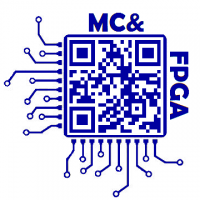“Microprogramming” Course in the Knowledge Field 12 “Information Technology”
Mykhailo Petryshyn, Lubomyr Petryshyn
V International Scientific and Practical Conference Theoretical and Applied Aspects of Device Development on Microcontrollers and FPGAs (MC&FPGA-2023), Kharkiv, Ukraine, 2023, pp. 29-31.
Date of Conference: 22–23 June 2023
Abstract
Microprogramming is used to implement the control logic of a computer’s central processing unit at a low level of programming. The microprogram code specifies the sequence of the processor elementary operations execution, ensures the order of complex instruction sets implementation, and allows the design of high-level programming language commands. The relevance of studying the theory, methods, and techniques of microprogramming in higher education institutions allows students to acquire skills in developing functionally oriented processors structures, their command set, as well as system programming skills. The purpose of studying microprogramming is to gain an understanding of how flexible and a computer’s central processor efficient control is achieved using microcode. This allows microprogram optimization, improving performance and ensuring system functionality. In summary, students will gain an understanding of how hardware and software interact at a low level.
Keywords: microprogramming, course, processor control, student.
Full Text: PDF
References
- W. Stallings, “Computer Organization and Architecture,” 11th ed., Pearson, 2021.
- J. Ledin, “Modern Computer Architecture and Organization,” Packt Publishing, 2020, 560 pages.
- M. Murdocca, V. Heuring, “Computer Architecture and Organization,” John Wiley & Sons, 2007.
- D. Comer, “Essentials of Computer Architecture,” 2nd Ed., Chapman and Hall/CRC, 2017, 511 p.
- L. Petryshyn, D. Sala, „Architecture of the multiprocessor computerized management systems,” In: Zarządzanie przedsiębiorstwem : teoria i praktyka 2014 / Sc red. Piotr Łebkowski, Kraków, Wydawnictwa AGH, 2014, pp. 196–198.
- J. D. Dumas, “Computer Architecture: Fundamentals and Principles of Computer Design,” 2nd Ed., CRC Press; 2016, 462 p.
- L. Petryshyn, “Matematičeskie modeli obsluživaniâ informacionnyh processov v mnogoprocessornyh komp’ûterizovannyh sistemah upravleniâ — Mathematical models of information processes maintenance in multiprocessor computerized control systems,” In monography: Information Technology in Selected Areas of Management. / Sci. Ed. Lyubomyr Petryshyn. Published by AGH University of Science and Technology Press. Krakow, 2016. 152 p., pp. 11-32.
- P. Whatmough, G.-Y. Wei, D. Brooks, “Deep Learning for Computer Architects (Synthesis Lectures on Computer Architecture),” Morgan & Claypool Publishers, 2017, 124 p.
- B. Holdsworth, “Microprocessor Engineering,” Elsevier, 2013. 352 р.
- A. J. Dos Reis, “RISC-V Assembly,” Independently published, 2019, 155 p.
- A. Agrawala, T. G. Rauscher, “Foundations of Microprogramming: Architecture, Software, and Applications,” New York, Academic Press, 1976, 2021 p.
- W. Matthes, “Mikroprogrammierung. Prinzipien, Architekturen, Maschinen,” Logos, 2021.
- A. J. Dos Reis, “Constructing a Microprogrammed Computer,” Second Ed., Independently published, 2022, 189 p.
- “Microprogramming,” Merriam-Webster.com Dictionary, [Online]. Available: https://www.merriam-webster.com/dictionary/microprogramming. (accessed Mai 08, 2023).
- “An Introduction to Microprogramming,” IBM Corporation, 1971.
- M. J. Flynn, R. F. Rosin, “Microprogramming: An Introduction and a Viewpoint,” 1971, pp. 727-731, DOI: 10.1109/T-C.1971.223341.
- B. E. Cline, “Microprogramming Concepts and Techniques,” Petrocelli Books, 1981, 169 p.
- S. S. Husson, “Microprogramming. Principles and Practices,” Prentice-Hall, 1970.

